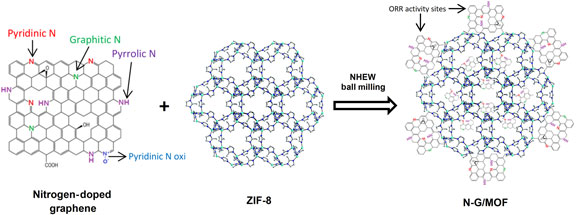Crossref Citations
This article has been cited by the following publications. This list is generated based on data provided by
Crossref.
Singh, Harsimranjit
Zhuang, Shiqiang
Nunna, Bharath Babu
and
Lee, Eon Soo
2018.
Thermal Stability and Potential Cycling Durability of Nitrogen-Doped Graphene Modified by Metal-Organic Framework for Oxygen Reduction Reactions.
Catalysts,
Vol. 8,
Issue. 12,
p.
607.
Tong, Jinhui
Li, Yuliang
Bo, Lili
Wang, Wenhui
Li, Tao
and
Zhang, Qi
2019.
Core-Shell Fe3O4@NCS-Mn Derived from Chitosan-Schiff Based Mn Complex with Enhanced Catalytic Activity for Oxygen Reduction Reaction.
Catalysts,
Vol. 9,
Issue. 8,
p.
692.
Singh, Harsimranjit
Zhuang, Shiqiang
Ingis, Benjamin
Nunna, Bharath Babu
and
Lee, Eon Soo
2019.
Carbon-based catalysts for oxygen reduction reaction: A review on degradation mechanisms.
Carbon,
Vol. 151,
Issue. ,
p.
160.
Sohrabi, Samaneh
and
Ghalkhani, Masoumeh
2019.
Metal–Organic Frameworks as Electro-Catalysts for Oxygen Reduction Reaction in Electrochemical Technologies.
Journal of Electronic Materials,
Vol. 48,
Issue. 7,
p.
4127.
Tajik, Somayeh
Beitollahi, Hadi
Nejad, Fariba Garkani
Kirlikovali, Kent O.
Van Le, Quyet
Jang, Ho Won
Varma, Rajender S.
Farha, Omar K.
and
Shokouhimehr, Mohammadreza
2020.
Recent Electrochemical Applications of Metal–Organic Framework-Based Materials.
Crystal Growth & Design,
Vol. 20,
Issue. 10,
p.
7034.
Qiao, Yu
Kong, Fantao
Zhang, Chaoqi
Li, Ruijing
Kong, Aiguo
and
Shan, Yongkui
2020.
Highly efficient oxygen electrode catalyst derived from chitosan biomass by molten salt pyrolysis for zinc-air battery.
Electrochimica Acta,
Vol. 339,
Issue. ,
p.
135923.
Kharissova, Oxana V.
Kharisov, Boris I.
Ulyand, Igor Efimovich
and
García, Tomas Hernandez
2020.
Catalysis using metal–organic framework-derived nanocarbons: Recent trends.
Journal of Materials Research,
Vol. 35,
Issue. 16,
p.
2190.
Guo, Xingguo
Wang, Qiuying
Xu, Ting
Wei, Kajia
Yin, Mengxi
Liang, Peng
Huang, Xia
and
Zhang, Xiaoyuan
2020.
One-step ball milling-prepared nano Fe2O3 and nitrogen-doped graphene with high oxygen reduction activity and its application in microbial fuel cells.
Frontiers of Environmental Science & Engineering,
Vol. 14,
Issue. 2,
Etienne, Ernst Emmanuel
Nunna, Bharath Babu
Talukder, Niladri
Wang, Yudong
and
Lee, Eon Soo
2021.
COVID-19 Biomarkers and Advanced Sensing Technologies for Point-of-Care (POC) Diagnosis.
Bioengineering,
Vol. 8,
Issue. 7,
p.
98.
Wang, Yudong
Nunna, Bharath Babu
Talukder, Niladri
Etienne, Ernst Emmanuel
and
Lee, Eon Soo
2021.
Blood Plasma Self-Separation Technologies during the Self-Driven Flow in Microfluidic Platforms.
Bioengineering,
Vol. 8,
Issue. 7,
p.
94.
Talukder, Niladri
Wang, Yudong
Nunna, Bharath Babu
and
Lee, Eon Soo
2021.
Nitrogen-doped graphene nanomaterials for electrochemical catalysis/reactions: A review on chemical structures and stability.
Carbon,
Vol. 185,
Issue. ,
p.
198.
Sanad, Mohamed Fathi
and
Sreenivasan, Sreeprasad T.
2022.
Electrochemical Applications of Metal-Organic Frameworks.
p.
135.
Talukder, Niladri
Wang, Yudong
Nunna, Bharath Babu
and
Lee, Eon Soo
2022.
An In-Depth Exploration of the Electrochemical Oxygen Reduction Reaction (ORR) Phenomenon on Carbon-Based Catalysts in Alkaline and Acidic Mediums.
Catalysts,
Vol. 12,
Issue. 7,
p.
791.
Tang, Liang
Xu, Qinshang
Zhang, Yu
Chen, Wenqian
and
Wu, Minghong
2022.
MOF/PCP-based Electrocatalysts for the Oxygen Reduction Reaction.
Electrochemical Energy Reviews,
Vol. 5,
Issue. 1,
p.
32.
Jayaramulu, Kolleboyina
Mukherjee, Soumya
Morales, Dulce M.
Dubal, Deepak P.
Nanjundan, Ashok Kumar
Schneemann, Andreas
Masa, Justus
Kment, Stepan
Schuhmann, Wolfgang
Otyepka, Michal
Zbořil, Radek
and
Fischer, Roland A.
2022.
Graphene-Based Metal–Organic Framework Hybrids for Applications in Catalysis, Environmental, and Energy Technologies.
Chemical Reviews,
Vol. 122,
Issue. 24,
p.
17241.
Sran, Balkaran Singh
Hwang, Jung Won
Chitale, Sachin K.
Kim, Jeong-Chul
Cho, Kyung-Ho
Jo, Donghui
Yoon, Ji Woong
Lee, Su-Kyung
and
Lee, U.-Hwang
2023.
Post-combustion CO2 capture of methyl and nitro mixed-linker CAU-10.
MRS Communications,
Vol. 13,
Issue. 2,
p.
343.
Li, Xinyi
Huang, Yangtian
Lu, Yubiao
Jia, Tianbo
Wang, Jianxin
and
Li, Peng
2023.
N-doped GO cathode catalyst boosting capacity of denitrification for air-cathode microbial fuel cell by shifting microbial community composition in treating marine wastewater.
Journal of Water Process Engineering,
Vol. 53,
Issue. ,
p.
103687.
Talukder, Niladri
Wang, Yudong
Nunna, Bharath Babu
Tong, Xiao
Boscoboinik, Jorge Anibal
and
Lee, Eon Soo
2023.
Investigation on electrocatalytic performance and material degradation of an N-doped graphene-MOF nanocatalyst in emulated electrochemical environments.
Industrial Chemistry & Materials,
Vol. 1,
Issue. 3,
p.
360.
Hosseini, Hadi
2024.
Handbook of Functionalized Carbon Nanostructures.
p.
509.
Talukder, Niladri
Wang, Yudong
Nunna, Bharath Babu
Tong, Xiao
and
Lee, Eon Soo
2024.
An investigation on the structural stability of ZIF-8 in water versus water-derived oxidative species in aqueous environment.
Microporous and Mesoporous Materials,
Vol. 366,
Issue. ,
p.
112934.
